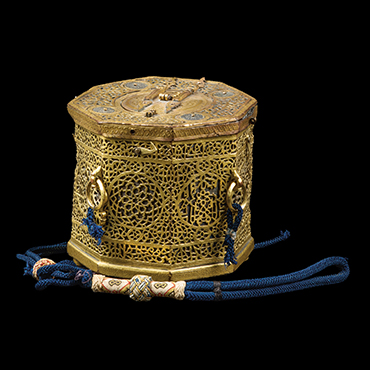In AH 1334/1916 CE Adela Crooke y Guzmán, countess of Valencia de Don Juan, and her husband established the Instituto de Valencia de Don Juan (IVDJ) in Madrid. The IVDJ is a private foundation that works to study and preserve Spanish art in Spain. One of the most important foundations of its kind in Spain, its holdings comprise historical, archaeological, and decorative art collections, and an archive library.
Amongst its most prominent collections are rare Islamic textiles that range from the earliest period of Umayyad rule, as well as ceramics including one of the major reference collections of Málaga and Manises lusterware. The rarest among these are the 9th-century AH/15th-century CE Fortuny Tile, one of two surviving large, lustered tiles bearing the Nasrid royal blazon, and the earliest of the surviving Alhambra vases. The IVDJ also holds important carpets including Spanish rugs from the 9th to 10th centuries AH/15th to 16th centuries CE, and Persian rugs including one of the Sanguszko group, a medallion rug, and a paradise park rug from the 10th century AH/16th century CE, as well as ivories including one of the few examples surviving from the mid-4th-century AH/mid-10th-century CE caliphal workshops located outside of Córdoba at the palace city of Madinat al-Zahra’.
The Institute joins AlMadar with a selection of its most splendid examples of Islamic works of art, mainly from Granada, that express the use of geometry as an artistic principle. Some works of art came from the Alhambra palace itself, including a unique pierced-work inkwell and floor tiles bearing the Nasrid royal blazon.
Inkwell
A unique survival, this inkwell is a rare example of pierced metalwork from the Nasrid era. The pierced work incorporates geometric patterns, scrolling vines with split palmettes, twisted ropes patterns, and inscriptions. Most likely made in a royal workshop, it can be compared with objects such as the pierced-work mosque lamp commissioned by the Nasrid ruler Muhammad III (r. AH 701–08/1302–09 CE) now exhibited at the Alhambra Museum. The inscriptions on the inkwell unfold in the upper and lower registers and have not yet been completely deciphered. In the central register, roundels with eight-pointed stars alternate with roundels with the words bi-Allah written in mirrored script.
The woven silk cords would have been used to hang the inkwell from the belt of a distinguished scribe. The inkwell was acquired from the now demolished Hospital de La Cruz in Cuéllar (between Segovia and Valladolid). It may have been brought to the hospital by its founder, Agustín Daza y Vázquez (AH 983–1067/1576–1657 CE), a priest and ecclesiastical dignitary from the region. He was also secretary to the Spanish Habsburg ruler, Philip IV, and may well have had access to and interest in such a splendid inkwell from Granada.
Granada, al-Andalus, 8th century AH/14th century CE
Found at the Hospital de la Cruz, Cuéllar, Spain
Gilded and silvered copper, niello, brass, silk passementerie, h. 10.5 × w. 9 cm
Instituto de Valencia de Don Juan. Madrid, 3075

